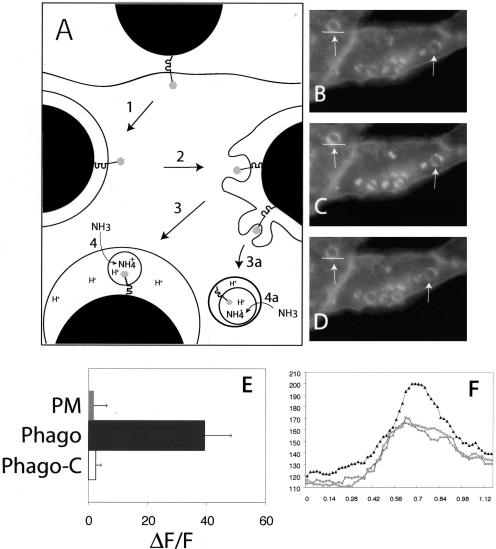Figure 4.
Translocation of the cytosolic tail of FcγRIIA to an acidic compartment during phagosome maturation. (A) Diagrammatic representation of the experimental protocol. Cells stably transfected with FcγRIIA-GFP were allowed to ingest opsonized latex beads (arrow 1). During the course of maturation the phagosomal membrane bearing FcγRIIA-GFP undergoes budding (2) and fission (3 and 3a). Fission results in the release of intraphagosomal vesicles (3) or the formation of multivesicular bodies containing FcγRIIA-GFP (3a). The lumen of the phagosome and of the MVB is acidic, leading to quenching of the fluorescence of GFP, which can be relieved by alkalinization induced by addition of ammonia (4 and 4a), added as NH4Cl. (B–D) Cells stably transfected with FcγRIIA-GFP were allowed to ingest opsonized latex beads for 45 min at 37°C. Fluorescence emission was acquired before (B) and after the addition of 10 mM NH4Cl (C). Another image (D) was acquired shortly after removal of NH4Cl. Representative phagosomes are denoted with arrows. Images are representative of three separate experiments. (E) Quantitation of fluorescence change induced by addition of NH4Cl in the immediate vicinity of the phagosome (Phago) and at the plasma membrane (PM). In separate experiments, cells prepared as above were treated with 250 nM concanamycin A for 15 min before image acquisition and addition of NH4Cl (Phago-C). Results are presented as the fluorescence change (ΔF) induced by NH4Cl normalized to the total initial fluorescence of the phagosome (F). Data are means ± SE of at least 50 individual determinations. (F) Scans of the fluorescence intensity of one of the phagosomes in B–D. The region denoted by the white line was scanned and is plotted in F to demonstrate the increase in fluorescence induced by ammonia. The ordinate shows the relative fluorescence intensity (RFI). Circles and squares represent fluorescence intensity before addition and after removal of NH4Cl, respectively, and black triangles represent the intensity in the presence of NH4Cl.

